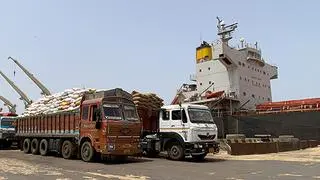Maharashtra, Tamil Nadu, Karnataka, Uttar Pradesh and Gujarat are aspiring to become $1-trillion economies in the next five years. Several conditions would have to be met to make this even remotely possible.
To achieve this, these States will have to record a growth of above 30 per cent a year, assuming a normal depreciation of rupee. If the rupee continues to slide at the rate it did this year, then these States will have to grow even at a higher rate. This aspiration may seem utopian.
Nevertheless, these ambitious targets could help push States to re-evaluate their policies, programmes and effectiveness of administration.
Six parameters
Six parameters are central to examining the feasibility of converting this aspiration to reality — the level of GSDP and its structure, including the best possible growth achieved in the last decade; the level of workforce and its structure; institutional credit relative to GSDP; the capital expenditure of the State; policy dynamism; and the effectiveness of administrative apparatus. A snapshot of these parameters is shown in Table 1.

Maharashtra tops in GSDP, at nearly one-and-half times the GSDP of any of the other four States. Average CAGR of GSDP growth of these States during 2011-12 to 2021-22 has varied from 9.3 per cent for Maharashtra to 13 per cent for Karnataka.
It has been 10.2 per cent (Uttar Pradesh), 11.2 per cent (Tamil Nadu) and 11.8 per cent (Gujarat) compared to the All India CAGR of 10.3 per cent.
Again, each of these States have recorded much higher growth during intervening years, indicating that the potential growth could be raised.
The incremental output critically depends on investment. Since States do not provide estimates of GSDP from demand side, the investment level can be worked out through proxy variables of capital expenditure of the State, besides institutional credit flow.
Maharashtra and Tamil Nadu are relatively better placed in terms of institutional credit support while Uttar Pradesh has higher capital expenditure. Currently, the private investment level is tepid. As for the economic profile of these States, Gujarat and Tamil Nadu have a relatively vibrant secondary sector, while in Karnataka and Maharashtra, services have been dominant. Uttar Pradesh has a more agrarian economy.
Given the tepid private investment, States’ higher capital expenditure provides only a limited acceleration to growth. Further, low penetration of institutional credit and low credit-deposit ratio make States more of cash collection centres for the banking system and they may perhaps not be actively seeking clients.

Workforce rate
Another contributing factor for higher growth is workforce participation (WPR). WPR of Uttar Pradesh at 34.5 per cent of population is lower than the national average of 39.8 per cent. Workforce participation of women in Uttar Pradesh at 16.2 per cent, is also below the national average of 24.2 per cent. Higher workforce participation is both necessary for economic empowerment of women and higher growth.
These States are not short on policy dynamism. In Ease of Doing Business Ranking, Gujarat, Karnataka and Tamil Nadu have been the top achievers, Maharashtra and Uttar Pradesh are in the achievers category.
In Innovation Index, Karnataka, Maharashtra, Tamil Nadu and Uttar Pradesh are among the first seven States, with Gujarat lower at 14th place. Uttar Pradesh has announced a New Industrial and Investment policy, which aims at increasing the investment rate to 43-47 per cent with public investment and private investment sharing the burden.

Every State has developed a mechanism to attract private investment through special summits. But more than the announcements, it is the actual flows that matter.
SDG indicators, proxy for implementation, indicate that Uttar Pradesh is the lowest in this cohort.
Another critical factor is quality of labour force, areas where they are engaged and where incremental workforce may find their placement. The accompanying table provides the percentage of workforce in different occupations in these States in 2020-21.
Gujarat is most favourably placed with nearly a fifth of workforce in vibrant manufacturing and utilities. Shifting labour from agriculture to new areas may be time consuming and may entail higher transaction costs.
As for data for MSMEs, they do reveal opportunities at the bottom layer. Gujarat and Maharashtra are relatively better placed in terms of value added per worker, per MSME unit and capital invested compared to the other States.
While there has been an increasing emphasis on training through PM Kaushal Vikas Yojana, craftsmen training and training under National Apprenticeship and others, this is yet to get reflected in the GSDP numbers.
Further, the placement under PM Kaushal Vikas Yojana in these States is low. It is 5.9 per cent for Maharashtra, 12.9 per cent for Karnataka, 18.2 per cent for Uttar Pradesh, 18.5 per cent for Gujarat and 25 per cent for Tamil Nadu (for aggregate data until January 2021).
What is the takeaway? While having ambitious aspirations is good, the current snapshot of data shows that there is much work to be done. Investment, particularly from private investors, increased workforce participation, transfer of workers to vibrant and innovative sectors, would be necessary to accelerate growth. Meeting the $1-trillion GSDP target in the 4-5 years is no doubt a daunting task.
Singhi was Senior Economic Advisor, Ministry of Finance. Gopalan was Finance Secretary. Views are personal








Comments
Comments have to be in English, and in full sentences. They cannot be abusive or personal. Please abide by our community guidelines for posting your comments.
We have migrated to a new commenting platform. If you are already a registered user of TheHindu Businessline and logged in, you may continue to engage with our articles. If you do not have an account please register and login to post comments. Users can access their older comments by logging into their accounts on Vuukle.